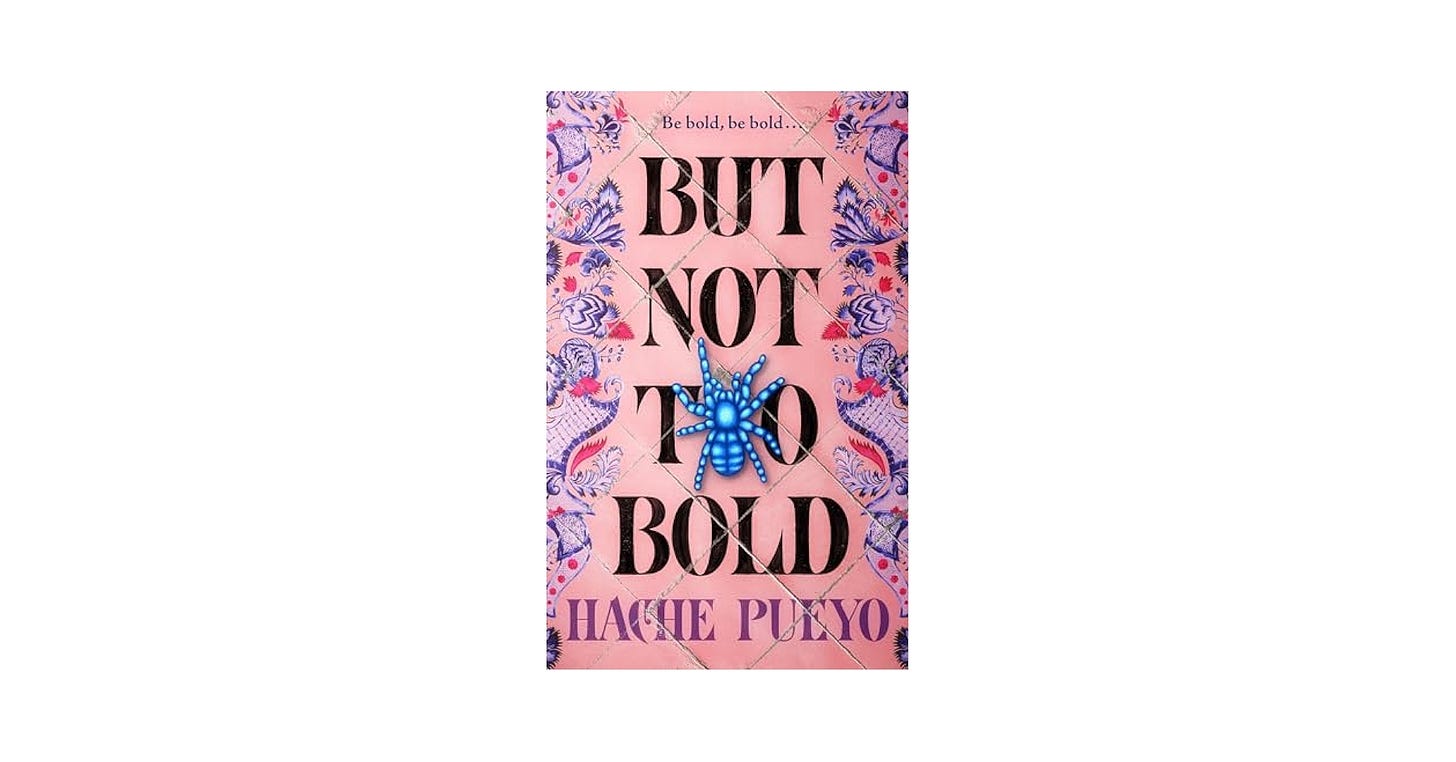
I recently had the pleasure of interviewing H. Pueyo to discuss their new book, But Not Too Bold.

Dannie Lynn Fountain (DLF): Let’s start with the title. But Not Too Bold feels almost like a paradox—calling attention to both courage and caution at once. How do you see the interplay between these two concepts in the book? Do you believe there’s such a thing as “too bold”?
H. Pueyo (HP): The title is a reference to Mr. Fox, a variation of Bluebeard, in which the protagonist finds the inscription “Be bold, be bold, but not too bold (lest that your heart’s blood should run cold)” in different parts of her new husband’s castle. Bluebeard punishes curiosity—or excessive “boldness”, in Mr. Fox’s case—but it’s this very instinct that helps the protagonist escape her fate. In But Not Too Bold, Dália must follow a very delicate balance of boldness and caution to deal with her precarious new position… But I like to think her curiosity pays off.
Dannie Lynn Fountain (DLF): As an arachnophobe and someone with a serious spider allergy, the cover of this book almost made me look away. But by the end of the book my perspective on spiders had changed profoundly—dare I say I maybe learned to even love them a little?! What are your own thoughts and perspectives of these often-misunderstood creatures?
H. Pueyo (HP): I’m delighted to hear you feel differently about them now, and that you gave it a chance despite your phobia! I’m extremely partial to spiders, as it probably shows—they were my favorite animal as a child, along with other arthropods and snakes and other unloved creatures. I even considered studying them for a while.

Dannie Lynn Fountain (DLF): But Not Too Bold touches on and uses a few different themes to share its message and lesson—memory, bravery, autonomy and self confidence, to name a few—what is the thread (or web, if you will) that connected all of these for you?
H. Pueyo (HP): It’s funny, I didn’t think of those themes separately as I was writing because I prefer not to think of themes when I write, I prefer to build them as the story progresses and leave their interpretation up to the reader. There are some things that appear more than others in my work, and memory and autonomy are definitely recurring ones. In But Not Too Bold, I wondered about how someone who lives for such a long time would deal with her memories, someone who is both so large and powerful compared to a human, but so isolated to the confines of her house, eager to connect but fading from the world. Then we have the humans, who have to find ways of accepting the nature of this creature while understanding their own mortality, and Dália herself, who grew up in this house and whose sense of self is so attached to her own job… Following this line of thought, everything started to connect for me.
Dannie Lynn Fountain (DLF): The book contains moments of vulnerability and emotional depth, but also of humor and wit. How do you balance these contrasting elements in your writing, and what role does humor play in navigating darker themes?
H. Pueyo (HP): I think contrasting emotions often coexist in life, so it feels natural to have them coexist in fiction too. There are mundane situations that can feel suffocating, while others might be deeply distressing and we still find humor to deal with them. That being said, I see But Not Too Bold as more of a light-hearted story than anything!
Dannie Lynn Fountain (DLF): You use language in such a precise way throughout the novel—there’s a real cadence to the dialogue and prose. Can you talk about your approach to the rhythm of the language? Was it a conscious decision, or did it emerge naturally as you wrote? Also, if not too spoilery, your approach to Anatema’s two voices.
H. Pueyo (HP): Thank you so much! I care a lot about the rhythm and the aesthetics of writing, and one of my favorite parts about the process is the moment of finding the particular cadence of a story. In this one, I felt like the prose needed to mirror the exuberance of the house and that it had to be as visual as possible. As for Anatema, I wanted her other voice to be different in form—but still readable.
Dannie Lynn Fountain (DLF): Each of the central and secondary characters in But Not Too Bold have light and dark elements to who they are. Is there a character that surprised you the most as you developed each of these parts of them?
H. Pueyo (HP): Not really! I think I expected Anatema to be more terrifying before I started writing, but she’s more of an odd character, which in turn made the story more whimsical than creepy.
Dannie Lynn Fountain (DLF): And finally—we cannot talk about the caution of “but not too bold” without looking outward to today’s society. How can readers find their own inner boldness or bravery to use their voice after they finish reading But Not Too Bold?
H. Pueyo (HP): Hopefully, they won’t have to face issues such as a house-sized spider that wants to eat you, but if they do, this might be an interesting (if outlandish) guide of how to deal with it.
FIN.
Thank you so much to H. Pueyo for taking the time!
About H. Pueyo: Hache Pueyo is an Argentine-Brazilian writer and translator. She won an Otherwise Fellowship for her work with gender in speculative fiction, and her work has appeared as H. Pueyo in The Magazine of Fantasy & Science Fiction, Clarkesworld, Strange Horizons, and The Year’s Best Dark Fantasy & Horror, among others. Her bilingual collection, A Study in Ugliness & Outras Histórias, came out in 2022.
You can find But Not Too Bold at all your favorite book retailers.



